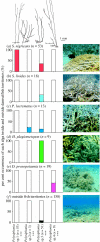A novel obligate cultivation mutualism between damselfish and Polysiphonia algae
- PMID: 17148297
- PMCID: PMC1833977
- DOI: 10.1098/rsbl.2006.0528
A novel obligate cultivation mutualism between damselfish and Polysiphonia algae
Abstract
In cultivation mutualisms, farming animals prepare fields for cultivars, enhance their growth and harvest them. For example, in terrestrial ecosystems, plant-herbivore cultivation mutualisms arose between humans and their crops only relatively recently. We discovered an obligate cultivation mutualism between a damselfish and an alga in a coral reef ecosystem. The damselfish, Stegastes nigricans, manages algal farms through territorial defence against the invading grazers and through weeding of unpalatable algae. As a result, the algal farms of S. nigricans are dominated by one species, Polysiphonia sp. We performed an exhaustive survey of algal assemblages inside and outside the territories of five damselfish species around the Ryukyu Islands, Japan, using molecular and morphological characteristics. Polysiphonia sp. 1 grew exclusively inside the farms of S. nigricans, and never elsewhere. Since only Polysiphonia sp. 1 is harvested and consumed by the damselfish as a staple food, this interdependent relationship is an obligate cultivation mutualism. This is the first record of an obligate plant-herbivore cultivation mutualism in a marine ecosystem. Our data also suggest that three other Polysiphonia species are facultatively mutual with, commensal with, or parasitic on other damselfish species.
Figures


References
-
- Aanen D.K, Eggleton P, Rouland-Lefèvre C, Guldberg-Frøslev T, Rosendahl S, Boomsma J.J. The evolution of fungus-growing termites and their mutualistic fungal symbionts. Proc. Natl Acad. Sci. USA. 2002;99:14 887–14 892. doi:10.1073/pnas.222313099 - DOI - PMC - PubMed
-
- Branch G.M. The biology of limpets: physical factors, energy flow, and ecological interactions. Oceanogr. Mar. Biol. Ann. Rev. 1981;19:235–380.
-
- Ceccarelli D.M, Jones G.P, McCook L.J. Territorial damselfishes as determinants of the structure of benthic communities on coral reefs. Oceanogr. Mar. Biol. Ann. Rev. 2001;39:355–389.
-
- Eriksson B.K, Johansson G. Effects of sedimentation on macroalgae: species-specific responses are related to reproductive traits. Oecologia. 2005;143:438–448. doi:10.1007/s00442-004-1810-1 - DOI - PubMed
-
- Harlan J.R. 2nd edn. American Society of Agronomy; Madison, WI: 1992. Crops and man.
Publication types
MeSH terms
Substances
Associated data
- Actions
- Actions
- Actions
- Actions
- Actions
- Actions
- Actions
- Actions
- Actions
- Actions
- Actions
- Actions
- Actions
- Actions
- Actions
- Actions
- Actions
- Actions
- Actions
- Actions
- Actions
- Actions
- Actions
- Actions
- Actions
- Actions
- Actions
- Actions
- Actions
- Actions
- Actions
- Actions
- Actions
- Actions
- Actions
- Actions
- Actions
- Actions
- Actions
- Actions
- Actions
- Actions
- Actions
- Actions
- Actions
- Actions
- Actions
- Actions
- Actions
- Actions
- Actions
- Actions
- Actions
- Actions
- Actions
- Actions
- Actions
- Actions
- Actions
- Actions
- Actions
- Actions
- Actions
- Actions
- Actions
- Actions
- Actions
- Actions
- Actions
- Actions
- Actions
- Actions
- Actions
LinkOut - more resources
Full Text Sources
Molecular Biology Databases
Research Materials

